Many people avoid growing indoor plants, because they think houseplants require a great deal of care to grow successfully. Or perhaps you’ve tried it and it just didn’t work out.
Don’t worry, I’m introducing the Pothos, a perfect, easy-care houseplant for beginners. The pothos is one of the more popular houseplants for its trailing stems and dark green, heart-shaped leaves.
- Related: Care Guides for Houseplants
Pothos Plant Overview
The Pothos, officially named Epipremnum Aureum, is one of the easiest houseplants to care for.
Pothos is called by many names, you may hear it referred to as:
- Golden pothos
- Taro Vine
- Ivy Arum
- Money Plant (if only!)
- Hunter’s Robe
- Devil’s Ivy or Devil’s Vine
Interesting tidbit, it’s most likely called the Devil’s Ivy because it seems impossible to kill and has great low light resistance. It practically grows in the dark.
This tropical forest plant is native to the Caribbean, Mexico, and South America. When not out in the wild, it lives and flourishes happily inside homes, offices, and apartments worldwide.
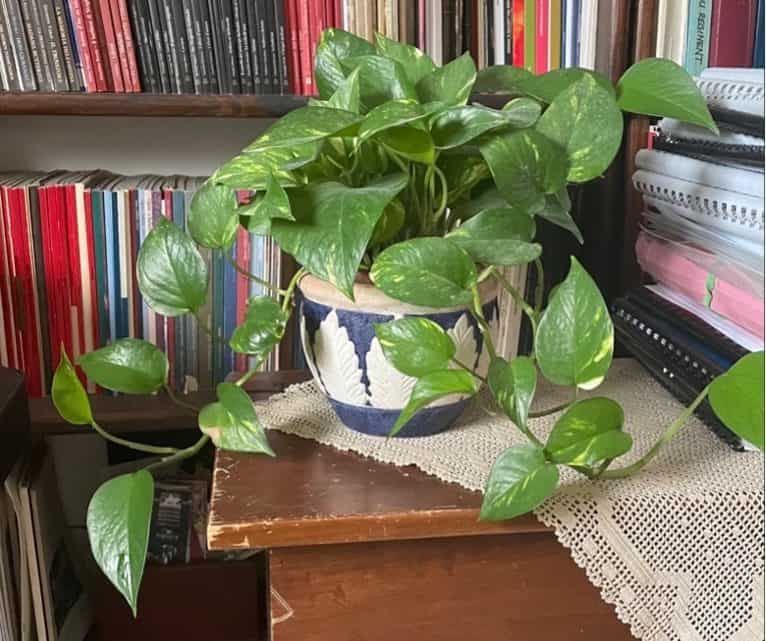
They’re well known for the varieties that have developed with different types of leaf variegation and leaf patterns. The dark green leaves will have patches of different colored patches, like white, yellow, or light green. Some recommended varieties of the pothos:
- Marble Queen – Well-known for its dark green and creamy-white leaves. Needs more light than other pothos.
- Neon Pothos – Bright chartreuse leaves. Does not need much light and good for darker spaces.
- Pearls and Jade – A smaller, patented variety of the ‘Marble Queen’ that grows slower than other varieties. Instead of creamy-white streaks, it’s usually small dots.
- Silver Satin – Has silver spots on its dark green leaves. Great for hanging baskets and doesn’t need as much water and light as others.
The pothos is a favorite houseplant for many plant enthusiasts for the pothos vine. These tropical vines generously fill up with pointed, heart-shaped green leaves that add color and decoration to just about any room. Most cultivars with leaves will be variegated, although some versions may have solid green leaves.
I actually have one in my bathroom. This lovely decorative plant thrives in low, indirect light. If you are looking for a variegated plant for a room that doesn’t get much direct light, not to worry, the pothos is a great candidate.
But the real advantage is that it does not require a great deal of attention. If you are busy or have a habit of forgetting your houseplants, the pothos is the perfect houseplant with limited care needed.
In its natural habitat of the rain forest, it will grow to be quite large and invasive. Very few regions in North America can support growth outside. The most likely will be the southern United States or coastal areas, if there is a shady area.
If your pothos grows too long indoors, just prune it back a bit to influence the shape of your plant and the length of its vines. Should you find dried out or yellowing leaves, putting the stem into water will have it thriving in no time.
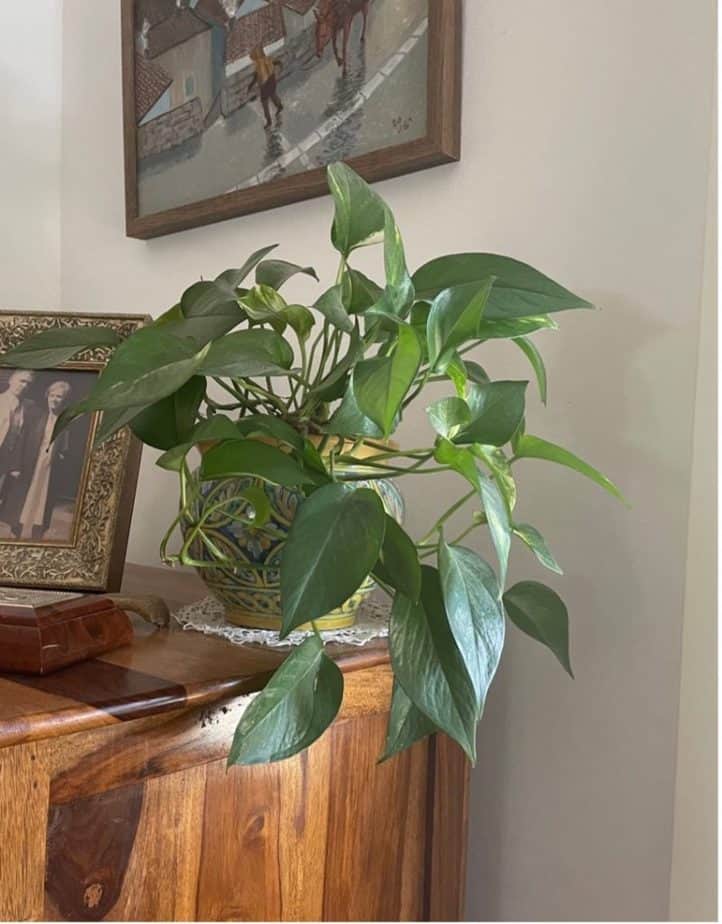
The Pothos Care Guide
Soil for Pothos Plants
The proper soil is fundamental for the overall health and beauty of houseplants. Natural soil will usually include various amounts of silt, sand, and clay together with organic matter.
Regardless of the mix, a soil bed needs a good equilibrium between retaining and draining water, hosting nutrients, aerating plants, and keeping them anchored in place. The wrong soil bed can contribute to root rot or dried out plants.
Pothos plants definitely prefer dry soil to soggy soil. They do not enjoy sitting in a wet soil bed at all. Good, well-draining potting soil/mix is important. You can mix in a bit of perlite or coco coir to improve drainage capability. The soil must ideally balance its water retaining capacity with its ability to drain.
Soil pH would be the best if slightly acidic somewhere between 6.0 and 6.5. If you want to make your own potting mix, try one part perlite, two parts peat moss, and one part pine bark fines.
If your topsoil seems to always be wet, it’s probably not draining well due to poor soil. Change up the soil mix and try fresh potting soil. I can’t emphasize how important proper drainage is to the health of your pothos plant. If the plant’s roots sit in water continually for long periods of time, basically your plant will drown.
Should you, at some point, want to repot your pothos, change the soil completely with ordinary, well-draining potting soil. Consider repotting if the roots have overtaken the container or if the plant appears rootbound.
Temperature for Pothos Plants
As a tropical plant, the pothos prefers warm and humid, but can survive in a multitude of temperatures. However, the ideal temperature for growing falls between 70 °F and 90 °F.
The lower end of the range is usually around common room temperature. Temperatures that fall under 70 °F or that raise above 90 °F will slow growth considerably.
A pothos can survive the occasional colder temperature that falls to 50 °F, but below this temperature it will die. If you live in a colder region, you’ll want to place these lovely plants away from cold windows and doors.
Light for Pothos Plants
The pothos is a popular houseplant for beginners, because it does not require direct bright sunlight. On the contrary, direct sunlight can burn leaves. The pothos however, loves bright light that is not direct. It will also do well in a low light environment.
If leaves are pale, it may be getting too much sunlight. If your pothos has variegated green leaves and there’s a loss of variegation, it’s probably getting too little light. It may revert to leaves that are entirely green as a result.
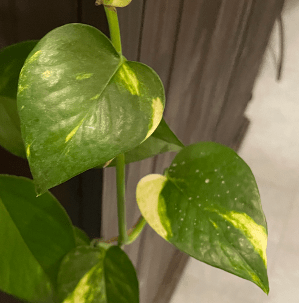
Location of the Pothos
Consider placing this potted plant on a ledge, bookshelf, or hang it from the ceiling. Since it grows vines that cascade down, placing it high up will allow you to appreciate the beauty of this plant.
The pothos can also be placed with a pole for the fantastic vines to climb up or with a trellis for the vines to latch onto through their sticky aerial roots. Whatever your interior decorating tastes, the pothos is a delightful addition.
Water and Humidity for Pothos Plants
A pothos will generally thrive if it is watered once a week especially in the spring and summer. If you live in a very hot, arid climate, you may need to water two times a week.
Generally, in the autumn and winter seasons, watering once every ten days to two weeks is sufficient. You’ll want to check on this depending on where you live too. While a pothos can survive a period of drought, it will not do well when over watered. Consistently soggy roots is not something the pothos likes.
If you see the leaves drooping, your pothos is saying it would like a drink. If it goes without water for too long, leaves will start falling off.
Pothos likes its humidity to measure 50% or higher. If you want to increase the humidity for your pothos, adding a plant humidifier is the best solution or a moss pole.
- Related article: Best Plant Humidifiers
Often people refer to misting, however this only works until the plant dries. Overdoing misting will increase the possibility of fungal infestation or even pest infestation. You can mist occasionally, but if your location is on the dryer side, consider a humidifier.
If you live in a very humid area, misting will not be necessary and could actually create problems if air circulation is poor. I have found that the pothos plants I keep in the bathrooms do very well thanks to natural humidity from the shower, etc.
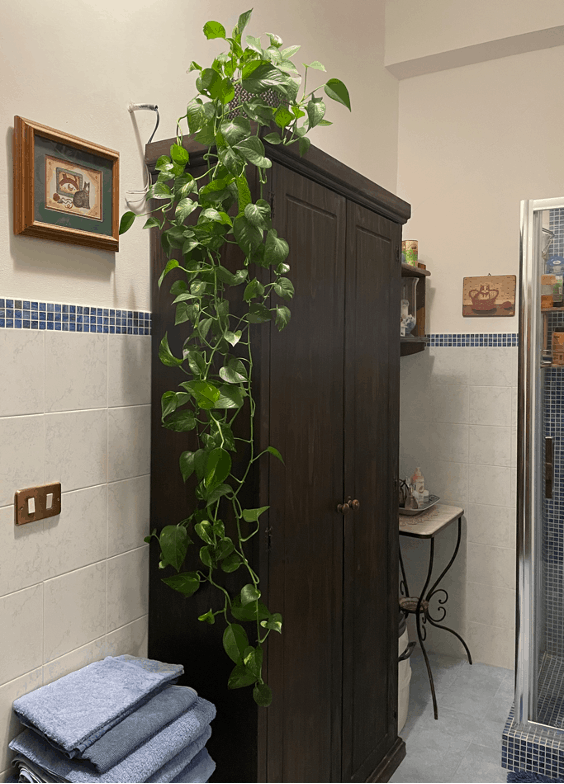
The best way to check your humidity is with a hygrometer, a small instrument that is portable and can test the relative humidity in any room. This Govee hygrometer on Amazon is a popular choice.
There are a few signs that your pothos might need a more humid environment:
- The leaves droop
- The leaves have brown edges
- The plant is wilting
- Leaves begin to yellow
These signs might also indicate lack of water, but if everything seems right and your plant is showing these characteristics, consider that lack of humidity may be the culprit.
Fertilizing for Pothos Plants
As a light feeder, there is no reason to fertilize the pothos plant continuously. However, a snack once a month will most certainly be appreciated using a balanced water-soluble fertilizer, compost solution, or seaweed solution.
Pruning for Pothos Plants
Pruning is something that will contribute to the health of your plant. If this plant is permitted to grow with no pruning, it will grow and grow in length. However, it won’t produce that nice, bushy look so many of us appreciate.
To properly prune, use a pair of clean sterilized scissors (you can sanitize with alcohol), cut the pothos at the end or tip. This will stimulate side growth from another point on the vine or stem.
You can do this to the entire plant, depending on the shape you are trying to obtain. Your pothos clippings can even be used to propagate and create new plants. Place the piece of stem in water or directly in the soil, taking care that the soil has good drainage.
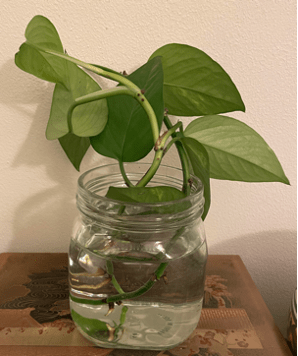
Pothos Plant Propagation
This is quite easy. Just cut a piece of your pathos vine and place the stem that has a node on it, in a glass or vase of water. Nodes are brownish or rusty in color.
Water should be changed often for your stem cutting and if your local area’s water has a high amount of chlorine in it, use bottled water. Now wait for it to develop roots, which should happen after approximately fifteen days.
You can then transplant the pothos to potting soil. New roots are delicate, so take care when moving them.
Instead of the water, you can also place a stem clipping directly in the soil, taking care that the water drainage is good.
Repotting or propagating a pathos can often save the life of the plant if it is dying. Remember to include a node in the clipping because new roots will emerge from the nodes.
Common Plant Pests, Diseases and More
This is a hardy plant that isn’t going to die on you very easily. A pothos plant will communicate if it’s not feeling well. If your pothos appears ill or as if it is dying, let’s consider what the underlying problem might be. Here are some common tell-tale signs of problems.
Yellow Leaves
Yellow leaves can be the result of a number of causes.
One reason is it’s usually an indication of a soil mix that is not ideal. Yellow means your pothos isn’t getting sufficient oxygen due to over watering, which in turn implies that your soil bed is not draining correctly.
They can be an indication of root rot, which is a fungal problem that occurs in overly wet conditions. Allowing the soil bed to dry out thoroughly before watering again will help.
Yellow leaves may also be an indication of too little or too much fertilizer.
Leaves turning yellow can also indicate too much direct sunlight. Also, spider mites may begin feeding on the underside of leaves, and they will also turn yellow. Will talk more about pests below.
Soft Roots
Soft roots or tissue growing just above ground will indicate a fungal problem. Check the soil and drain any excess water.
Wilting Leaves
Usually this will indicate that the plant needs water. Check the leaves. If the plant feels very soft, it implies that the plant needs some attention.
Plant Pests / Insects
Spider mites love pothos plants, so if they have a chance, they will be invasive. These mites are white and will feed on newer, juvenile leaves, creating holes. If you find holes on your leaves, it’s likely the spider mites are at play.
Pothos do not need medications. A mix of neem oil and water should be sufficient for any pest infestations.
To remove spider mites, first spray the infected leaves with warm water. Afterward, spray them with neem oil or insecticidal soap, like this Natria insecticidal soap on Amazon. Be sure to spray all of the leaves.
If you don’t want to use those sprays, you can also try using one liter of warm water with one tablespoon of salt. Spray the plant thoroughly, then spray again just with water.
Pothos and Pets
The pothos is not a pet-friendly plant. The pothos plant is poisonous for both humans and animals if chewed, eaten or ingested. I highly recommend placing it out of the reach of children and pets.
The pothos leaves produce and contain a great deal of insoluble calcium oxalate crystals, which specifically irritates the digestive tract and the mouth. Its leaves are highly toxic to cats, dogs, and birds.
For those of you who have aquariums, pothos is not an aquatic plant and should not be kept in an aquarium.
Should your pet vomit, drool excessively, or seem to have difficulty breathing, take it to your veterinarian immediately and inform the vet that you suspect pothos poisoning.
Pothos poisoning symptoms include:
- Oral irritation – mouth, lips, tongue
- Vomiting
- Excessive drooling
- Mouth pain or discomfort
- Foaming at the mouth
- Eye irritation
- Your pet paws at its mouth or oral cavity.
- Difficulty breathing
- Difficulty when swallowing
- Loss of appetite
- Diarrhea
- Tremors
Pothos Plants Final Thoughts
Apart from being incredibly an easy to take care of, the pothos is also one of NASA’s air cleansing plants (source). Similar to the peace lily, the pothos cleans toxins from the air such as benzene and formaldehyde fumes, as well as carbon monoxide.
This plant is not only a great houseplant, but a terrific plant for your bedroom too. It’ll help ensure you’re breathing lots of oxygen while sleeping.
Definitely take a look at the pothos if you don’t already have one. They’re the perfect plant for people who don’t have green thumbs, but are plant enthusiasts and want the green beauty of houseplants around.
For more houseplant growing guides, click on one that interests you:

